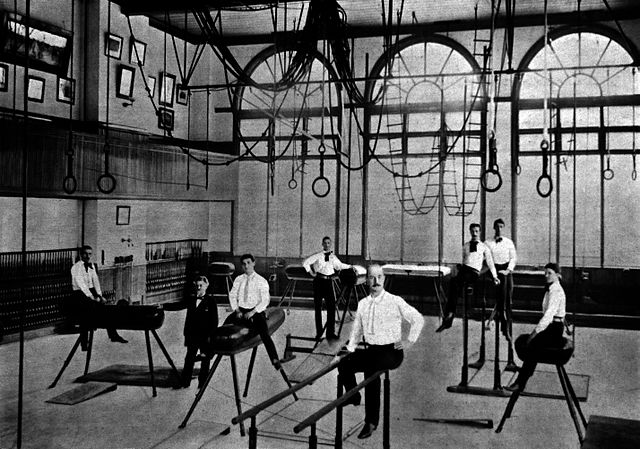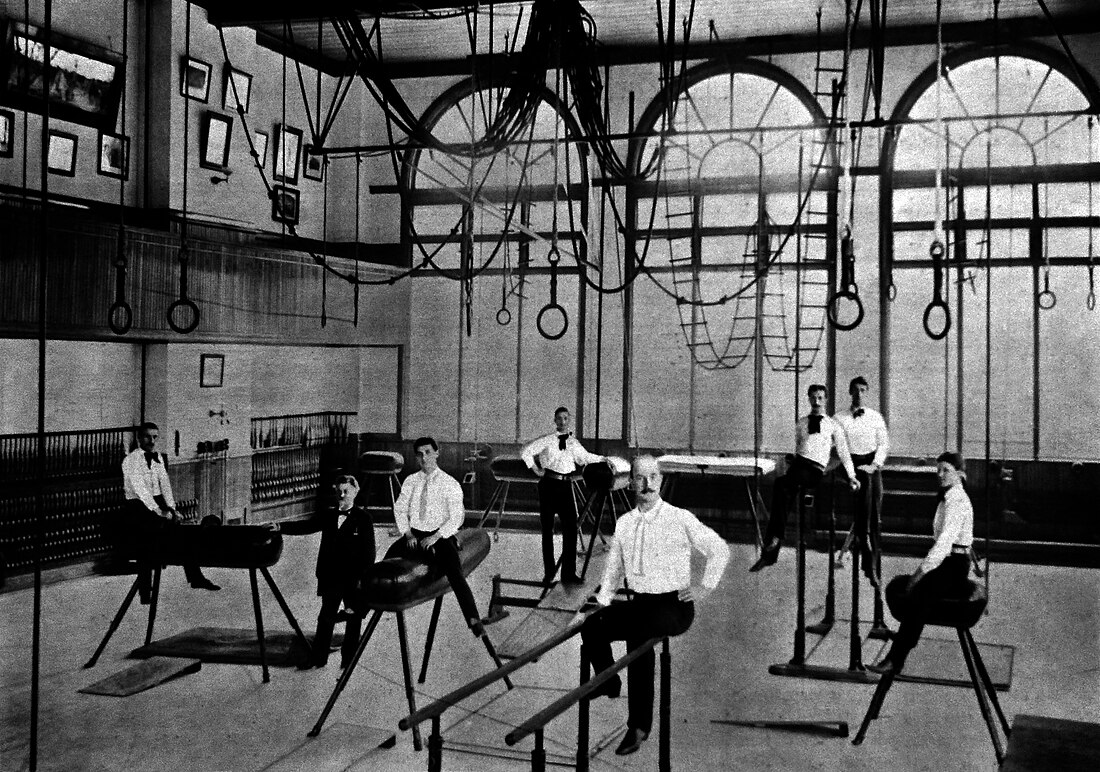Turners
German-American gymnastic club members From Wikipedia, the free encyclopedia
Turners (German: Turner, German: [ˈtʊʁnɐ] ⓘ) are members of German-American gymnastic clubs called Turnvereine. They promoted German culture, physical culture, and liberal politics. Turners, especially Francis Lieber (1798–1872), were the leading sponsors of gymnastics as an American sport and the field of academic study.


In Germany, a major gymnastic movement was started by Turnvater ("father of gymnastics") and nationalist Friedrich Ludwig Jahn in the early 19th century when Germany was occupied by Napoleon. The Turnvereine (German: [ˈtʊʁnfɛɐ̯ˌʔaɪ̯nə] ⓘ; "gymnastic unions"; from German turnen meaning “to practice gymnastics,” and Verein meaning “club, union”) were not only athletic but also political, reflecting their origin in similar ethnocentric "national gymnastic" organizations in Europe (such as the Czech Sokol), who were participants in various national movements for independence. The Turner movement in Germany was generally liberal in nature, and many Turners took part in the Revolutions of 1848.[1]

After the failure of the 1848 Revolution in Germany, the Turner movement was suppressed, and many Turners left Germany, some emigrating to the United States, especially to the Ohio Valley region, Wisconsin, Missouri, and Texas. Several of these Forty-Eighters went on to become Union soldiers, and some became Republican politicians.[2] Besides serving as physical education, social, political, and cultural organizations for German immigrants, Turners were also active in public education and labor movements.[3][4][5] They were leading promoters of gymnastics in the United States as a sport and as a school subject.[6] In the United States, the movement declined after 1900, and especially after 1917.[7]
History in the United States
Summarize
Perspective

The Turner movement was preceded by the first wave of gymnastics in the United States in the 1820s, led by Germans, such as Charles Beck and Charles Follen, and Americans, such as John Neal. Beck opened the first gymnasium in the U.S. in 1825 at the Round Hill School in Northampton, Massachusetts.[8] Follen opened the first college gymnasium and the first public gymnasium in the States in 1826 at Harvard College and in Boston, Massachusetts, respectively.[9] Neal was the first American to open a public gymnasium in the U.S. in Portland, Maine in 1827.[10] He also documented and promoted these early efforts in the American Journal of Education[11] and The Yankee, helping to establish the American branch of the movement.[12]
The Turnvereine made a contribution to the integration of German-Americans into their new home. The organizations continue to exist in areas of heavy German immigration, such as Iowa, Texas, Wisconsin, Indiana, Ohio, Minnesota, Missouri, Syracuse, New York, Kentucky, New York City, Sacramento, and Los Angeles.
About 1000 Turners served as Union soldiers during the Civil War. Anti-slavery was a common element, as typified by Carl Schurz. Many Republican leaders in German communities were members. They provided the bodyguard at Abraham Lincoln's inauguration on March 4, 1861, and at his funeral in April 1865. In the Camp Jackson Affair, a large force of German volunteers helped prevent Confederate forces from seizing the government arsenal in St. Louis just prior to the beginning of the war.[13] After the Civil War, the national organization took a new name, Nordamerikanischer Turnerbund, and supported German-language teaching in public high schools, as well as gymnastics. Women's auxiliaries were formed in the 1850s and 1860s. The high point in membership came in 1894, with 317 societies and about 40,000 adult male members, along with 25,000 children and 3000 women.[14]
In the 1904 Olympics several competitors represented various Turners organizations in Missouri, Illinois, Pennsylvania, New Jersey and New York, and some of the teams at the Olympics were sponsored by Turners organizations.
Like other German-American groups, the Turners experienced suspicion during World War I, even though they now had very little contact with Germany. German-language instruction ended at many schools and universities, and the federal government imposed restrictions on German-language publications. The younger generation generally demanded the switch to the exclusive use of English society affairs, which allowed many Turner societies to continue to function.[3]
Cultural assimilation and both World Wars with Germany took a gradual toll on membership, with some halls closing and others becoming regular dance halls, bars, or bowling alleys.[5] As of 2011, 54 Turner societies still existed around the U.S. The current headquarters of American Turners is in Louisville, Kentucky.[15]
In 1948, the US Post Office issued a 3-cent commemorative stamp to mark the 100th anniversary of the movement in the country.
The Turnverein in Sacramento, founded in 1854, claims to be the oldest institution within the city still in existence.[16] The Turnverein Vorwaerts of Fort Wayne, Indiana, owned the Hugh McCulloch House from 1906 until 1966.[17]: 2 It was listed on the National Register of Historic Places in 1980.[18]
Gallery
Vintage photos of the Milwaukee Turnverein
- 1866
- 1869
- 1875
- 1879
- 1915
Other Wisconsin Turners in 1915
- Kenosha
- Madison
- Madison Bears (seniors)
- New Holstein
- Sheboygan
Monuments in the United States
- Jahn Monument in St. Louis, Missouri
- Davenport, Iowa Turngemeinde Monument
Jahn Monument in Berlin with memorial plaques from American Turnvereine
- The Berlin monument
- Chicago, 1861
- Cincinnati, 1865
- Philadelphia, 1861
- Washington, D.C., 1911
Turner Halls
- Turner Hall
Boonville, Missouri - Turner Hall
Buffalo, Iowa - Pilsen Turner Hall, Chicago, Illinois
- Central Turner Hall (1848), Cincinnati, Ohio
- Germania Singing and Sport Society, Columbus, Ohio
- Central Turner Hall (1888), Davenport, Iowa
- East Turner Hall (1891), Davenport, Iowa
- Northwest Turner Hall (1882), Davenport, Iowa
- Turner Hall
Dubuque, Iowa - Turner Hall (1888), Duluth, Minnesota
- Elgin Turners
Elgin, Illinois - Turner Hall
Galena, Illinois - Holyoke Turner Hall
Holyoke, Massachusetts - Independent Turnverein
Indianapolis, Indiana - South Side Turnverein Hall (1900), Indianapolis, Indiana
- South Side Turnverein Hall, Indianapolis, Indiana
- Detail, South Side Turnverin Hall, Indianapolis, Indiana
- Germania Turnverein, Lancaster, Pennsylvania
- Turner Hall (1868), Madison, Wisconsin
- Interior ca. 1910, Turner Hall, Milwaukee, Wisconsin
- Turners Hall (1868)
New Orleans, Louisiana - Turner Hall
New Ulm, Minnesota - Turn-Verein, East 4th Street, New York, New York
- Central Turn-Verein, East 67th Street, New York, New York
- Turnhalle
Rock Island, Illinois
See also
- German-Americans in the Civil War
- WMWG-LP: Owned by the Milwaukee Turners
- George Brosius
- Forty-Eighters
- Sokol, a comparable movement for Czechs in Central Europe (Austria-Hungary) and the United States
References
Further reading
External links
Wikiwand - on
Seamless Wikipedia browsing. On steroids.













































